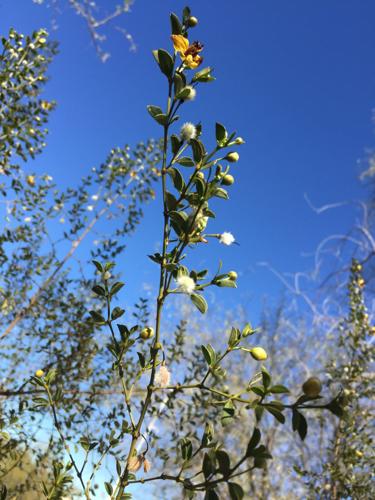Q: I have a 6-year-old miniature orange tree. It has lush green foliage but to date I have yet to see the first orange. It is on an irrigation system and is fertilized by our landscaper. Do these trees take this long to bear fruit or could there be something else going on?
A: Usually a tree is producing fruit before it is 6 years old. If your tree is producing flowers but no fruit, it could be a pollination problem. If the tree isn’t producing flowers, there a few potential problems. The most common are a fertilization or water problem, so it would be good to know what kind of fertilizer and irrigation schedule your landscaper is using.
Typically, citrus fertilizer requirements are based on the type and size of the tree. For example, a small orange tree, 2 to 3 feet tall, requires 0.25 to 0.50 pounds of nitrogen per year. This amount is applied in thirds, each third being applied in January/February, March/April, and May/June. If you don’t want to do the fertilizer math, we have a handy chart to help based on the percentage of nitrogen in your bag of fertilizer. Search for az1671-2015.pdf on the Internet.
For irrigation, make sure you are providing drip emitters in a circle around the root zone at the drip line of the tree. The amount of water delivered should allow the water to reach 36 inches deep in the soil. You can check the depth with a soil probe. Timing for the irrigation is once every seven to 10 days in the summer, 10 to 14 days in the spring/fall, and every 14 to 21 days in the winter.
Q: My Tangerine tree is quite large and has “suckers” growing up from ground. Can I dig these up with a root ball? Will these produce fruit if grown? Folks and common sense tells me that coming from below “Graft” area that they will grow trees but, NOT bear fruit. Also, I live a mile south of the old Desert Treasures orange groves. So what happened to the “Thermal Belt” that used to be in this area? Because now we freeze like the rest of town!
A: Any suckers growing from below the graft union on the tree will be from the rootstock. You are correct in saying that the growth from below the graft will grow and it may even produce fruit but it will not be edible. The rootstock is chosen based on its hardiness rather than its fruit quality.
Since these suckers take energy to produce, it is best to prune them off whenever you see them so the tree can put its energy into something you might find tasty. I checked with our University of Arizona Climate Scientist, Mike Crimmins, and there is no thermal belt we are aware of having been in your area. This has been a colder year than normal with 10 days having freezing events so far. The average is 16 for the whole season and there is plenty of winter left. So it’s possible you are noticing it more this year.
Q: What is the best month in the Tucson/Marana area to trim back hibiscus and bougainvillea plants? Also, I need to cut back and trim greasewood so what is the best month for that shrub?
A: Hibiscus species should be pruned in late winter to promote growth in the spring because it blooms from buds produced in the same season. Bougainvillea species can be pruned once the danger of frost has past, usually mid-March. During the growing season, vigorous shoots can be pruned as needed. Greasewood, aka creosote (Larrea tridentata), doesn’t require any pruning except to control the size and that can be done any time.
Q: We have been having a bad stink bug infestation (hemipterans not pinacate beetles) the past couple of years in the garden. This past year they were out early and often and basically ruined the entire tomato crop. We are at 5,000 feet and don’t plant until May. First fruits are almost never harvested before Aug. 15. It is a cold zone with 46 nights at or below freezing so far this winter (no that is not a misprint). Do you have any suggestions to deal with these pests?
A: There are a couple things you can do. First, it is helpful to scout once a week when your crop comes up to see when the stink bugs begin to lay eggs. They are laid in a mass of 10-25 on the underside of leaves and look like tiny barrels. You can reduce the population significantly by removing the eggs before they hatch. Once they hatch and are actively feeding you can spray them and the sooner, the better while they are still young. If your crop is organic there is a product called PyGanic that works pretty well on hemipterans. If you use conventional pesticides, there are more choices but they may have some restrictions on when you apply them relative to when you harvest.





